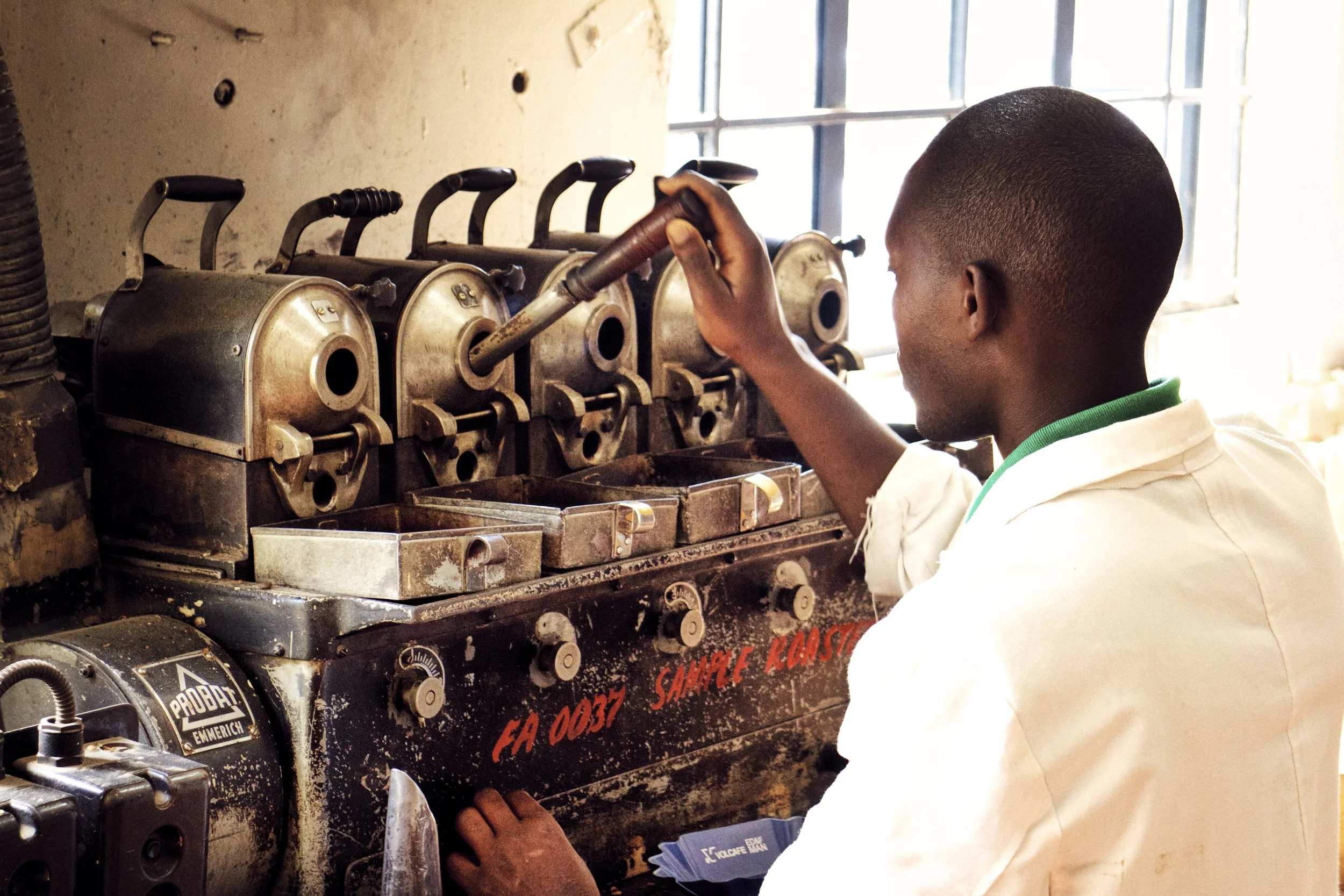Sample Roasting
Photo courtesy of Dear Coffee Buyer by Ryan Brown
Since starting Prodigal, I’ve been thinking a lot about sample roasting. Sample roasting is arguably more important to final product quality than production roasting is, so I have been remiss in not discussing sample roasting more in the past.
What is sample roasting?
Sample roasting involves roasting small quantities of coffee, usually as little as 50g up to 200g, but most commonly 100g, to test and choose which lots of green coffee to buy. Sample roasting is also sometimes used to “profile” a coffee before production roasting, but the utility of such “profiling” is dubious. The word profiling can mean various things, but here it refers to the practice of attempting to learn how to roast a new coffee on a small machine, with the intention of transferring that knowledge to a larger machine. Unfortunately, it is difficult to transfer more than general insights (how much relative power does a coffee require to roast, approximately how does it behave around first crack, what roast color tastes good, etc.) from a small machine to a larger one. Profiling in this way can give one a “ballpark idea” of how to approach a coffee, but cannot, with our current technology and understanding, tell one precisely how to roast a coffee in a larger machine.
Types of sample roasters
Historically, most sample roasters were small drum roasters with open-faced drums, such as in the photo above. While such dinosaurs often churn out surprisingly delicious coffee, they make consistent, predictable results nearly impossible. For a deep dive into why these machines offer poor consistency, and how to modify them for better results, please see my post HERE
In recent years, a plethora of +/-500g drum roasters have hit the market that offer more controlled and consistent, if not always as delicious, sample roasts. Most such machines come from China, have similar features, and none stand out as particularly special. The positive aspects of these machines include fully modulating control over gas, drum RPM, and airflow, and easy connection to software such as Cropster or Artisan. However, some of these machines roast with too much conduction, most have slow bean probes in frankly stupid locations, and some have the reliability of an Edsel. If you don’t know what an Edsel is, consider yourself fortunate.
If you are going to buy one of these small drum roasters, I recommend getting one of the cheaper ones, because they are all similar, with nearly identical designs, and usually require the user to replace and move the BT probe, possibly the gas-pressure gauge, and often a few other small features.
More recently, air roasters such as the Ikawa, Kaffelogic, and Roest have hit the market. The potential roast quality out of air roasters is generally superior to that of drum roasters, since air roasters transfer little to no heat by conduction, but instead use convection, which makes it easier to develop coffee and avoid roasty (not a real word) flavors. Until recently, I was frustrated by the control and repeatability offered by most of these machines, although all have the ability to produce delicious coffee at least some of the time.
What I use
Prior to 2022, my preferred sample roaster was a 500g drum roaster. Such machines offer good data quality down to 100g batches, and offer probably the most insight into how a coffee may behave in a production roaster. Roast quality was “pretty good” but consistent and predictable. I’d rather roast at a quality level of 8/10 consistently than have erratic, and occasionally better, sample roasts, because one needs consistency to give each green sample a fair trial.
More recently, at Prodigal I began using the Roest. For full disclosure, I did not pay for the machine. You don’t have to trust me, but no amount of free stuff could make me use anything but the best possible machine at Prodigal, or could compel me to write a blog post about a product. I needed a great machine to get the most out of my coffee, and for years I’ve been begging manufacturers to build exactly what Roest has built.
My relationship with Roest was rocky at first, as I had a disagreement with someone at the company about roasting data. Because we had such different perspectives, I invited some of the Roest folks as guests at my roasting seminar in Boston last year. They took notes, asked questions, shared their experience designing machines with the class, and — wonderfully — embraced the importance of an effective warmup and between-batch protocol. They were excited, because they recognized an effective BBP was not only necessary for good consistency (yes, even in an air roaster), but also essential for successful automation and replication. I was excited, because a manufacturer finally engaged and cared about the importance of a quality warmup and BBP :). Further discussions led to the addition of an inlet-temperature probe, because using an inlet-temperature recipe is the most effective way to manage an air roaster consistently (more on that in a future post).
A roast using an inlet-temperature profile (please ignore the “yellowing” note)
Last year, Roest added the ability to create customized warmup and BBP profiles, and now the machine automatically triggers the BBP upon dropping a batch. I cannot say how happy that makes me as a roaster, and also the only person yelling about the importance of an effective BBP for years. The last piece of the puzzle happened this month, as Roest now offers the option to create inlet-temperature profiles based on bean-temperature set points instead of time. Such as system makes consistent, predictable, high-quality roasting possible in a way it had never been before.
I’m grateful to Roest for the machine, but more grateful they care about details, consistency, and continual improvements. Choosing a sample roaster is finally a no-brainer for me.
NB: Readers may notice some similarities between the Roest and the Decent espresso machine. I’m fond of both machines for similar reasons: each is a seamless marriage of user-friendly, clever software and hardware, both companies listen to feedback and rapidly improve and update their software and hardware, and they offer unparalleled control and real-time information while roasting and making espresso, respectively. Most importantly, each offers better coffee, more consistently, than any other machine in its category.
Roest screenshots: 1) An inlet-temperature profile 2)Profile log 3)Roast comparison
Portland Classes
Please join Samo Smrke and me for our masterclasses in Portland.
You can find tickets and details about my roasting masterclass HERE.
Tickets and details of Samo’s “Improving coffee with science” class can be found HERE
Prodigal Update
Prodigal is on hold for another month or two, while we finalize our permits and the installation of our IMF roaster . We may release a small amount of extremely delicious coffee in the next couple of weeks, as we have some stunning green that we want to roast while it is still incredibly fresh. We will update our mailing list and Instagram followers as soon as we know when we will get back to a regular roasting schedule.
Prodigal Coffee at SCA Expo
I’m pleased to announce you will be able to taste two smashing Prodigal coffees at SCA Expo, our washed Colombian “Finca La Indonesia” sidra and washed Colombian “Francy Castillo” geisha. I will roast both coffees on the ROEST, the machine I consider hands-down the best sample roaster.
You can taste Prodigal’s coffee brewed in the new NextLevel Pulsar by the fine folks of NextLevel (they will share Sivetz Roasters’ booth) and also at the ROEST booth. I will spend time brewing the coffees at the two booths, and I’ll post my schedule on Instagram on the day of the event so you know where to find me.
My intention is to not only showcase what the ROEST and Pulsar can do, but to make sure these are the two most memorable coffees you taste at Expo!
You can, of course, also taste Prodigal coffees at my Roasting Masterclass on Saturday.
Thanks to Apex Coffee Imports for sourcing two of the cleanest, prettiest, most floral coffees I have tasted in recent memory.
I look forward to seeing you in Portland!





